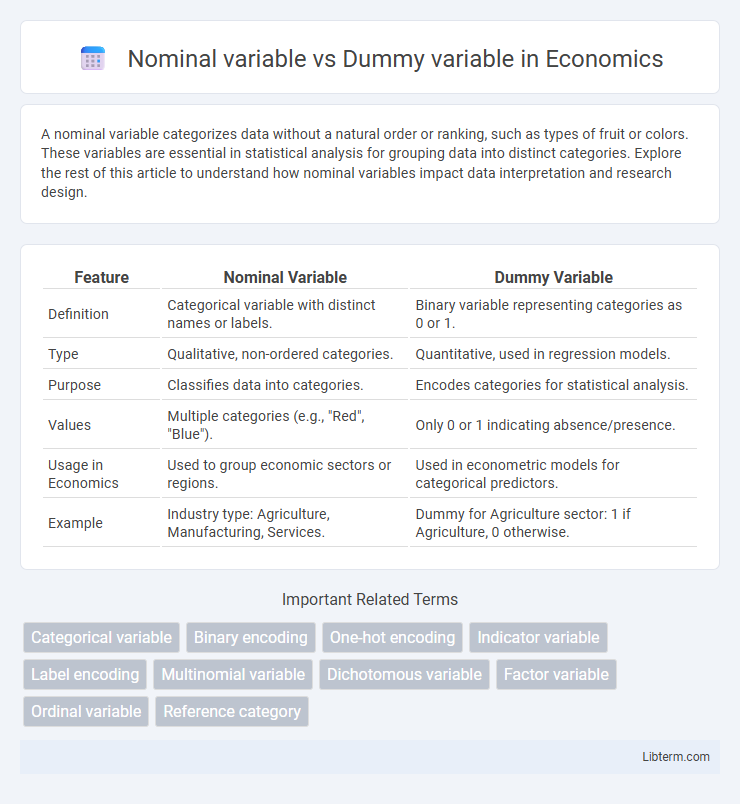A nominal variable categorizes data without a natural order or ranking, such as types of fruit or colors. These variables are essential in statistical analysis for grouping data into distinct categories. Explore the rest of this article to understand how nominal variables impact data interpretation and research design.
Table of Comparison
| Feature | Nominal Variable | Dummy Variable |
|---|---|---|
| Definition | Categorical variable with distinct names or labels. | Binary variable representing categories as 0 or 1. |
| Type | Qualitative, non-ordered categories. | Quantitative, used in regression models. |
| Purpose | Classifies data into categories. | Encodes categories for statistical analysis. |
| Values | Multiple categories (e.g., "Red", "Blue"). | Only 0 or 1 indicating absence/presence. |
| Usage in Economics | Used to group economic sectors or regions. | Used in econometric models for categorical predictors. |
| Example | Industry type: Agriculture, Manufacturing, Services. | Dummy for Agriculture sector: 1 if Agriculture, 0 otherwise. |
Introduction to Nominal and Dummy Variables
Nominal variables represent categories without any intrinsic order, such as gender, race, or brand names, and are essential in categorizing qualitative data. Dummy variables, also known as indicator variables, are binary variables created from nominal variables to enable their use in regression models by assigning values of 0 or 1. This transformation allows nominal categories to be quantitatively analyzed while preserving the categorical information.
Defining Nominal Variables
Nominal variables represent categories without any intrinsic order, such as colors, gender, or types of animals, serving as labels to distinguish different groups. These variables are qualitative and cannot be meaningfully ordered or ranked, making them essential in categorical data analysis. Converting nominal variables into dummy variables involves creating binary indicators for each category to enable their use in statistical models like regression analysis.
Defining Dummy Variables
Dummy variables are binary numerical representations used to encode nominal variables for statistical analysis, transforming categorical data into a format suitable for regression models. Each category of the nominal variable is assigned a separate dummy variable with values of 0 or 1 to indicate the absence or presence of the category. This encoding enables the inclusion of qualitative data in quantitative analysis while preventing multicollinearity through the exclusion of one reference category.
Key Differences Between Nominal and Dummy Variables
Nominal variables represent categorical data without any intrinsic order, such as gender or ethnicity, used to label categories distinctly. Dummy variables are binary indicators created from nominal variables to facilitate their inclusion in regression models, coded as 0 or 1 to denote the absence or presence of a category. The key difference lies in their usage: nominal variables capture categorical data broadly, while dummy variables transform these categories into numerical form for statistical analysis.
Applications of Nominal Variables in Data Analysis
Nominal variables categorize data without implying order, making them essential for labeling qualitative attributes such as gender, ethnicity, or brand names in data analysis. These variables enable segmentation and grouping of data to identify patterns or trends within distinct categories, facilitating marketing segmentation, survey analysis, and social science research. Transforming nominal variables into dummy variables allows their incorporation into regression models, enhancing predictive analytics and hypothesis testing.
How Dummy Variables Are Created from Nominal Variables
Nominal variables represent categorical data without inherent order, such as colors or types, and cannot be directly used in regression models. Dummy variables are created by converting each category of a nominal variable into separate binary variables, where each dummy variable takes the value 1 if the observation belongs to that category and 0 otherwise. This transformation allows nominal data to be incorporated into statistical models by enabling numerical representation while avoiding multicollinearity through the exclusion of one baseline category.
Importance of Dummy Variables in Regression Analysis
Dummy variables transform nominal variables into binary indicators, enabling regression models to incorporate categorical data effectively. Their importance lies in allowing the estimation of category-specific effects, enhancing model interpretability and accuracy. Without dummy variables, regression analysis cannot quantify the impact of categories with more than two levels, limiting its applicability in real-world datasets.
Common Mistakes When Using Dummy Variables
Common mistakes when using dummy variables include omitting the reference category, leading to multicollinearity issues known as the dummy variable trap. Another frequent error is treating nominal variables with multiple categories as continuous instead of creating separate dummy variables for each category. Ensuring proper coding and avoiding redundancy in dummy variables is essential for accurate model estimation and interpretation in regression analysis.
Practical Examples Illustrating Both Variable Types
A nominal variable represents categories without intrinsic order, such as blood types (A, B, AB, O), while a dummy variable transforms these categories into binary indicators for regression analysis, like coding blood type A as 1 and others as 0. For example, in a survey dataset, "Car Brand" is nominal (Toyota, Ford, Honda) and can be converted into dummy variables (Toyota = 1 if true, else 0) for statistical modeling. This distinction enables precise handling of categorical data in machine learning and econometric models, enhancing interpretability and predictive accuracy.
Summary and Final Thoughts on Nominal vs. Dummy Variables
Nominal variables represent categories without any intrinsic order, such as gender or color, while dummy variables transform these categories into binary indicators for use in regression models, enabling quantitative analysis. Using dummy variables ensures statistical models can include categorical data effectively by assigning 0s and 1s to represent the absence or presence of each category. Understanding the distinction is crucial for proper data encoding and accurate interpretation of model coefficients in statistical analysis.
Nominal variable Infographic

 libterm.com
libterm.com